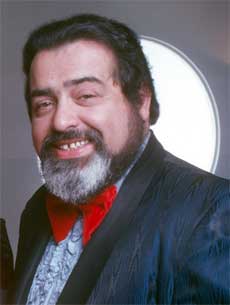
The Jazz Organ Scene
USA

|
Charlie Palmieri
Charlie (*1927 in South Bronx, NY), a.k.a. El Gigante Del Teclado (The Giant Of The Keyboards), had his roots in Puerto Rico from where his parents migrated. As a child, Charlie taught himself to play the piano by ear. He attended the public school system. At age seven, his father enrolled him at The Juilliard School, where he took piano lessons. By the time Charlie was 14 years old, he and his five-year-old brother, Eddie, participated in many talent contests, often winning prizes. It was at this time that his godfather introduced him to the music of the Latin bands, an experience which inspired him to become a musician.
In 1943, when still only 16 years old and still in high school, he made his professional debut as a piano player for the Osario Selasie Band. He graduated from high school in 1946, and immediately went to play for various bands. He made his recording debut with the song "Se Va La Rumba" as a member of the Rafael Muñiz Band. In October 1947, Tito Puente, the musical director of the Fernando Álvarez Band, was impressed with Palmieri and hired him to play for his band at the Copacabana Club; here he played with Puente until 1953 and, during the 1950s, he played with various bands. Besides having played with Tito Puente, he played with Pupi Campo's Band, and worked on Jack Paar's CBS daytime television show. Charlie also formed a couple of bands that performed at the Palladium Ballroom. Charlie worked for several years in Chicago, but returned to New York and formed a band called Charanga La Duboney. While performing at the Monte Carlo Ballroom, Charlie heard Johnny Pacheco playing the flute. The mixture of Pacheco's flute with the strings of the violins in Palmieri's band led to the 1960s Charanga craze in the United States. Palmieri was signed by the United Artists Record company and had several Latino hits. Palmieri did however suffer various setbacks - first Pacheco left the band and then United Artists cancelled his contract because of a conflict of interest with their other recording star, Tito Rodríguez. This led to Palmieri's signing with the Alegre Records label. When the Charanga craze declined in popularity, Palmieri switched to the new trend, the boogaloo, by replacing the flute and violins with three trumpets and two trombones, he also dropped the word "Charanga" from his bands' name and it became known simply as "La Duboney". In the 1970s, Charlie worked as the musical director for Tito Puente's television show, El Mundo de Tito Puente (Tito Puente's World). He also taught and lectured about Latin music and culture at various educational institutions. After reorganizing his band, Charlie played the organ. In 1971, he provided his organ playing talents to some of his brother's recordings. Among the artists Charlie worked with at one time or another were his brother Eddie, Celia Cruz, Tito Puente, Herbie Mann, Ismael Rivera, Rafael Cortijo, Ismael Quintana, Bobby Capó, Mongo Santamaría, Cal Tjader, and Ray Barretto. After a massive heart attack, Charlie soon recovered and returned to the music world as the member of various bands. Charlie gave private piano lessons. During this time he also appeared in the 1988 movie Salsa. Charlie died in 1988. from Wikipedia |
| contact: | |
| homepage: |
|
Live At Sing Sing Tico CLP 1303 recorded December 1972 in Ossining, NY/USA |
Eddie Palmieri, piano Ronnie Cuber, sax Jose Rodriguez, trombone Ray Maldonado, trumpet Cornell Dupree, guitar Harry Viggiano, guitar Charlie Palmieri, organ Hank Anderson, bass Andy Gonzalez, bass Reggie Barnes, drums Jerry Gonzalez, percussion Nicky Marrero, bongos Ray Romero, congas Charlie Santiago, timbales Arturo Campa, chorus Arturo Franquiz, chorus Lorene Hanchard, vocals Jimmy Norman, vocals Ismael Quintana, chorus Alvin Taylor, vocals Felipe Luciano, spoken word Paquito Navarro, spoken word |
 |
n/a |
| n/a |
|
You can view the video by clicking on the corresponding picture. For more videos search YouTube |
|

|
|
Back
If you don't see the left hand menu,
please go back to the homepage.
Back to the homepage